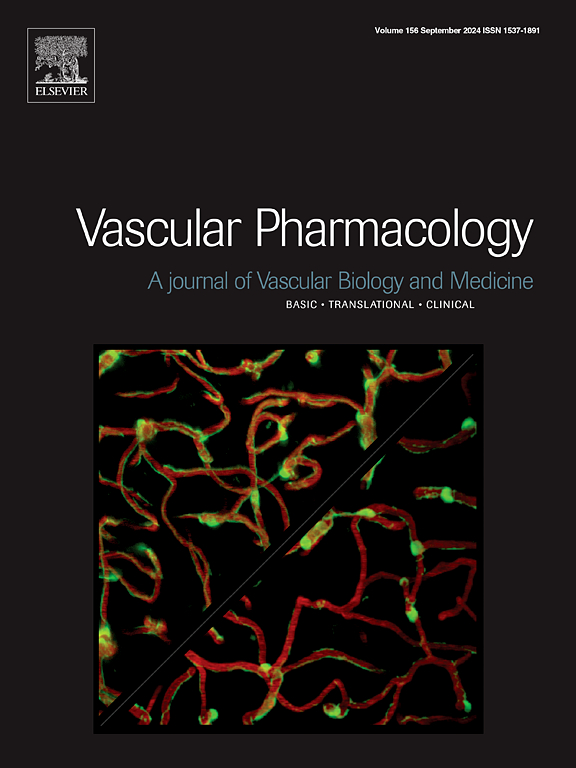Exploring the interplay between valvular and serum zinc and copper levels and disease markers in aortic stenosis
IF 3.5
3区 医学
Q2 PHARMACOLOGY & PHARMACY
引用次数: 0
Abstract
Aortic stenosis (AS) is a progressive condition characterized by valve calcification and significant morbidity, often requiring invasive intervention. The AS pathophysiology is multifaceted, with evidence suggesting a role for trace elements. However, whether zinc (Zn) and copper (Cu) are associated with valve calcification is unclear. This exploratory study assessed the Zn and Cu levels in the serum and aortic valves of AS patients undergoing surgical valve replacement and explored the relationships between trace elements and clinical and biochemical parameters to better understand their potential roles in AS pathophysiology. An inverse relationship was observed between serum Zn levels and systolic pressure gradients across the valve (p < 0.0001). Zn accumulation was identified in calcified aortic valves, suggesting a systemic redistribution of Zn during disease progression. The valvular Cu/Zn ratio was reversed (<1) compared to that in serum. The lipoprotein(a), an inflammatory marker, was positively correlated with serum Cu levels (p = 0.0007) and the Cu/Zn ratio (p = 0.02). However, no direct association was found between valvular Cu content and the AS severity. The findings suggest that Zn depletion in serum, coupled with its accumulation in calcified valves, reflects a disease-driven redistribution mechanism that may serve a protective role against calcification progression. Additionally, the study highlights a potential interplay between Cu metabolism and inflammatory processes in AS. Further research is required to determine whether therapeutic modulation of Zn levels could offer benefits in AS management.

探讨主动脉瓣狭窄和血清锌、铜水平与疾病标志物之间的相互作用
主动脉瓣狭窄(AS)是一种进行性疾病,以瓣膜钙化和显著的发病率为特征,通常需要侵入性干预。AS的病理生理是多方面的,有证据表明微量元素的作用。然而,锌(Zn)和铜(Cu)是否与瓣膜钙化有关尚不清楚。本探索性研究通过对行瓣膜置换术的AS患者血清和主动脉瓣中Zn、Cu含量的测定,探讨微量元素与临床生化参数的关系,以更好地了解其在AS病理生理中的潜在作用。血清锌水平与瓣膜收缩压梯度呈反比关系(p <;0.0001)。在钙化的主动脉瓣中发现了锌积累,提示疾病进展过程中锌的全身再分配。瓣膜铜锌比与血清相反(<1)。炎症标志物脂蛋白(a)与血清Cu水平(p = 0.0007)和Cu/Zn比值(p = 0.02)呈正相关。然而,没有发现瓣膜铜含量与AS严重程度之间的直接关联。研究结果表明,血清中锌的消耗,加上其在钙化瓣膜中的积累,反映了疾病驱动的再分配机制,可能对钙化进展起保护作用。此外,该研究强调了AS中铜代谢和炎症过程之间的潜在相互作用。需要进一步的研究来确定治疗性调节锌水平是否对AS的管理有益。
本文章由计算机程序翻译,如有差异,请以英文原文为准。
求助全文
约1分钟内获得全文
求助全文
来源期刊

Vascular pharmacology
医学-药学
CiteScore
6.60
自引率
2.50%
发文量
153
审稿时长
31 days
期刊介绍:
Vascular Pharmacology publishes papers, which contains results of all aspects of biology and pharmacology of the vascular system.
Papers are encouraged in basic, translational and clinical aspects of Vascular Biology and Pharmacology, utilizing approaches ranging from molecular biology to integrative physiology. All papers are in English.
The Journal publishes review articles which include vascular aspects of thrombosis, inflammation, cell signalling, atherosclerosis, and lipid metabolism.
 求助内容:
求助内容: 应助结果提醒方式:
应助结果提醒方式:


